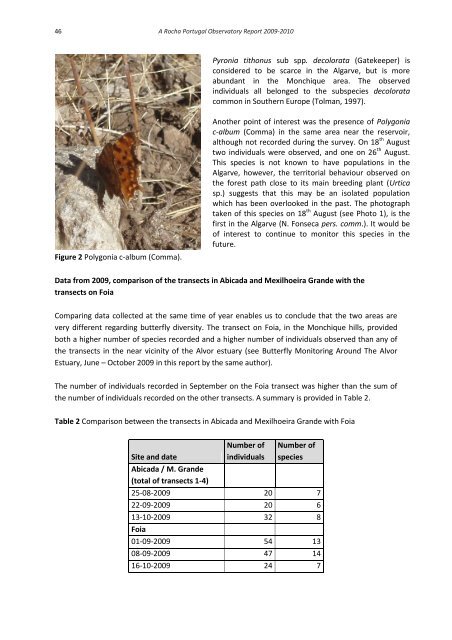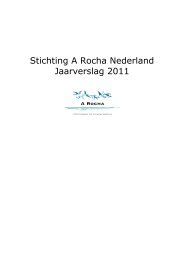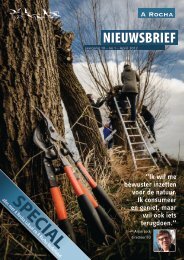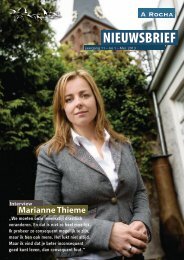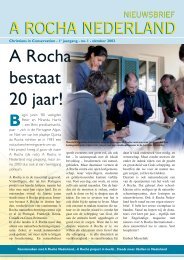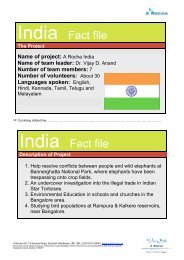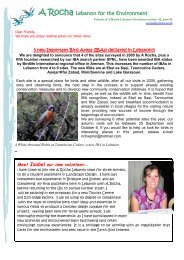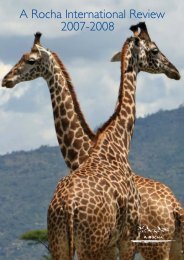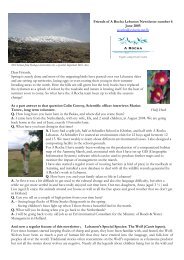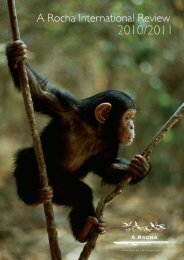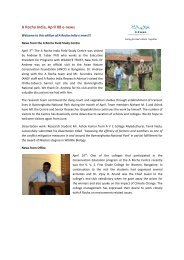A Rocha Portugal Observatory Report 2009-2010
A Rocha Portugal Observatory Report 2009-2010
A Rocha Portugal Observatory Report 2009-2010
You also want an ePaper? Increase the reach of your titles
YUMPU automatically turns print PDFs into web optimized ePapers that Google loves.
46 A <strong>Rocha</strong> <strong>Portugal</strong> <strong>Observatory</strong> <strong>Report</strong> <strong>2009</strong>-<strong>2010</strong><br />
Figure 2 Polygonia c-album (Comma).<br />
Data from <strong>2009</strong>, comparison of the transects in Abicada and Mexilhoeira Grande with the<br />
transects on Foia<br />
Comparing data collected at the same time of year enables us to conclude that the two areas are<br />
very different regarding butterfly diversity. The transect on Foia, in the Monchique hills, provided<br />
both a higher number of species recorded and a higher number of individuals observed than any of<br />
the transects in the near vicinity of the Alvor estuary (see Butterfly Monitoring Around The Alvor<br />
Estuary, June – October <strong>2009</strong> in this report by the same author).<br />
The number of individuals recorded in September on the Foia transect was higher than the sum of<br />
the number of individuals recorded on the other transects. A summary is provided in Table 2.<br />
Table 2 Comparison between the transects in Abicada and Mexilhoeira Grande with Foia<br />
Site and date<br />
Abicada / M. Grande<br />
(total of transects 1-4)<br />
Pyronia tithonus sub spp. decolorata (Gatekeeper) is<br />
considered to be scarce in the Algarve, but is more<br />
abundant in the Monchique area. The observed<br />
individuals all belonged to the subspecies decolorata<br />
common in Southern Europe (Tolman, 1997).<br />
Another point of interest was the presence of Polygonia<br />
c-album (Comma) in the same area near the reservoir,<br />
although not recorded during the survey. On 18 th August<br />
two individuals were observed, and one on 26 th August.<br />
This species is not known to have populations in the<br />
Algarve, however, the territorial behaviour observed on<br />
the forest path close to its main breeding plant (Urtica<br />
sp.) suggests that this may be an isolated population<br />
which has been overlooked in the past. The photograph<br />
taken of this species on 18 th August (see Photo 1), is the<br />
first in the Algarve (N. Fonseca pers. comm.). It would be<br />
of interest to continue to monitor this species in the<br />
future.<br />
Number of<br />
individuals<br />
Number of<br />
species<br />
25-08-<strong>2009</strong> 20 7<br />
22-09-<strong>2009</strong> 20 6<br />
13-10-<strong>2009</strong> 32 8<br />
Foia<br />
01-09-<strong>2009</strong> 54 13<br />
08-09-<strong>2009</strong> 47 14<br />
16-10-<strong>2009</strong> 24 7


